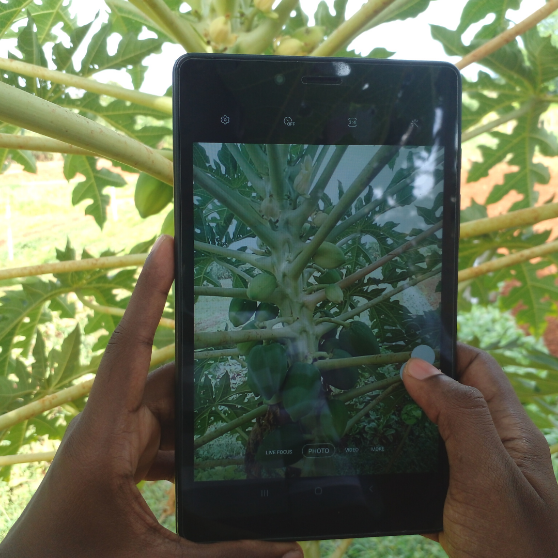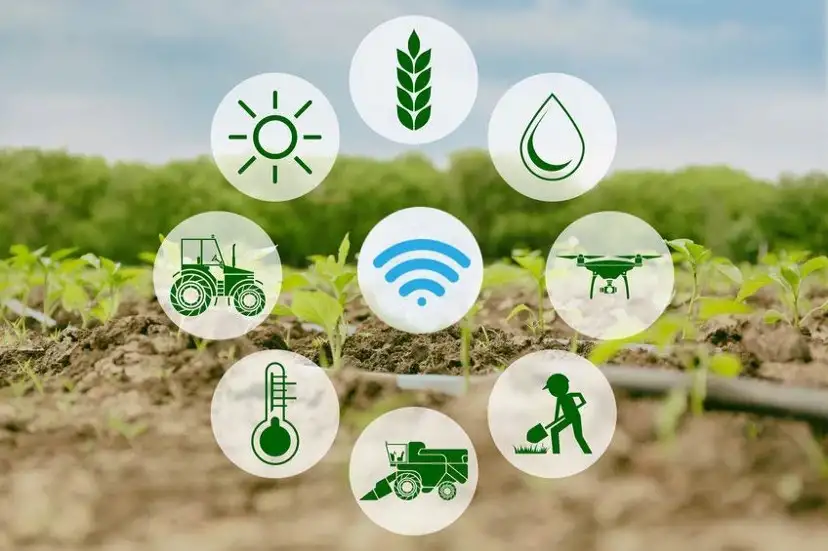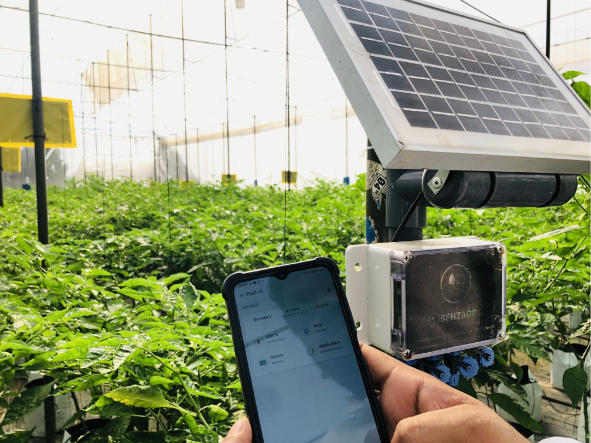PRECISION AGRICULTURE: TECHNOLOGY FOR SUSTAINABLE FARMING
Currently, technology is regarded as a major support pillar in almost all fields of human activity, including agriculture, where it has a significant impact on the quantity and quality of agricultural production. Precision agriculture management systems are evolving at a rapid pace. They allow farmers to find solutions to a variety of problems. Growers must become proficient with a variety of precision agriculture instruments in order to maximize output.
What is Precision Agriculture?
Dr. Pierre Robert, the father of modern precision farming, proposed precision agriculture in the 1980s. He developed the idea in college and spent many years researching and pioneering precision farming principles. ("Trimble,"2021)
The agricultural Fourth Industrial Revolution has resulted in a number of innovations known collectively as "agriculture." Modern technology allows for the precise, efficient, and effective processing of all data, among other things that will propel agriculture to new heights. The term "precision agriculture" implies accuracy and correctness in any production. The primary goal of precision farming is to adapt operations to the local environment by following the guiding principle of carrying out interventions at the appropriate time, place, and intensity.
GPS, drones, and satellite imagery are just a few of the smart farming technologies that can be integrated into such a system. Based on this data, farmers receive information on a wide range of topics, including crop status, weather forecasts, environmental changes, and so on. Another significant difference between precision farming and traditional agriculture is the ability to manage fields by dividing them into different zones rather than managing them as a continuous block. This type of zoning allows for different management options for specific field components, such as adjusting the amount of fertilizer, maximizing method movement, and using fuel more efficiently.
According to market research, the smart agriculture market is expected to be worth USD 36.24 billion by 2030, with a CAGR of 10.80%." in 2022(Straits research)

Why is precision agriculture important?
The ultimate goal of precision farming is to increase output with lower resource usage and maintain high quality standards.
for agricultural operations that can increase land production while optimizing efforts and resources and reducing consumption and waste. The task becomes more profitable for farmers and contractors as procedures are controlled more quickly and effectively, resulting in lower hourly expenses. They increase productivity while decreasing human resource fatigue for the environment, as more efficient resource use results in less fertilizer and herbicide waste, pollutants, and soil compaction.

Benefits of Precision Agriculture
Farmers are only now realizing the advantages of precision farming with IoT. Agricultural business owners see the use of technology in crop and cattle management as a way to improve decision-making, increase return on investment (ROI), and improve overall site security. Here are a few advantages of smart farming technology:
- Improved decision-making efficiency
- Access to farm records
- Access to farm records
When farmers use precision agriculture sensors to monitor soil moisture, crop health, and nutrient levels, they gain long-term access to priceless real-time data. In this manner, a site manager will be able to identify patterns and forecast adjustments, potential hazards, and yields, both during harvest and the growing season.
When farmers use precision agriculture sensors to monitor soil moisture, crop health, and nutrient levels, they gain long-term access to priceless real-time data. In this manner, a site manager will be able to identify patterns and forecast adjustments, potential hazards, and yields, both during harvest and the growing season.
Using technology to manage farms increases data accessibility. Precision agriculture allows team members to work outside of the office. Because of cloud-based technologies, all relevant information is freely accessible at any time from any device.

- Improved crop protection
Pesticide overuse is one of the causes of high crop and soil pressure. Farmers frequently use excessive amounts of nitrogen to protect their crops from insect pests. Chemical use is costly and reduces the site's environmental sustainability. Precision agriculture (PA) can assist in the environmentally friendly management of crop production inputs. PA can target fertilizer, seed, and chemical rates for soil and other conditions by using site-specific knowledge. One of the primary benefits of using Internet of Things-based smart farming technology is that it allows agriculture to better manage pests, apply chemicals only when necessary, and protect crops.

- Irrigation management
- Smart Monitoring
Crop irrigation system based on real-time microclimate parameter data obtained from Digi Plant and the weather station. Detect soil moisture and automate the irrigation system to provide adequate amounts of water as needed. (For more information, visit here)
SenzAgro's acoustic sensors provide real-time monitoring of climate parameters such as temperature, humidity, soil moisture, electric conductance, light, rain, and wind pattern.

Technologies used in Precision Agriculture
1.Yield monitoring and mapping
Grain yield monitors continuously measure and record grain flow in a combine's clean-grain elevator. Yield monitors connected to a GPS receiver can provide the data required for yield maps. Yield assessments are critical for making appropriate management decisions. However, when analyzing a yield map, it is also necessary to consider the soil, terrain, and other environmental factors. When used correctly, yield data provides valuable feedback for evaluating the effects of controlled inputs such as fertilizer, lime, seeds, herbicides, and cultural techniques such as irrigation and tillage.
2.Soil sampling and analysis.
Data about soil type, fertility, moisture content, and other factors can be collected using mobile apps. This data can be used to make irrigation, fertilization, and other crop management decisions.
3.Weather monitoring
Users can use hyperlocal weather data to determine when to plant, how much water to give crops, and when to harvest.
4.Equipment management.
Because agricultural equipment is expensive, farmers must keep track of it, schedule maintenance, and plan for repairs.
5.Remote sensing
Remote sensing is the process of collecting data from a distance. Sensors in agriculture can range from simple handheld devices to aircraft mounts and satellite-based systems. Remote sensing technologies are an important tool for site-specific crop management. Remote sensing has the potential to provide real-time analysis of a growing crop's attributes, which can aid in making timely management decisions that affect the crop's outcome.

How is GPS technology used in precision agriculture?
Satellites in the Global Positioning System send signals that allow GPS receivers to determine their location. Because this information is provided in real time, you can receive continuous position updates while moving. When precise location data is available at all times, it is possible to map soil and crop measurements. Using GPS receivers, which can be carried into the field or installed on tools, users can return to specific locations to sample or treat specific areas. GPS can be used for the following tasks:
- Mapping of irrigation systems, fields, and roads.
- Detection of areas with problem plants; soil testing in specific field areas.
- The tractor being driven with a parallel steering system.
- Precise seed and fertilizer application.
Due to the widespread use of GPS and GNSS systems, high-precision positioning systems held a dominant share of more than 27% of the precision farming market in 2018, as seen below:

Most Important technique in Precision Agriculture
Farmers use precision farming in a variety of ways in their farming operations to make resource management decisions based on in-field, real-time data collection.
The earliest and most widely used precision agriculture technique exists for variable-rate input applications. Growers can use VRT technology to apply fertilizer, chemicals, seeds, and other products to different parts of a field based on their needs. Farmers can also test the soil for nutrients such as nitrogen and feed only the areas that are deficient in those nutrients.
A group of soil cores collected at random locations throughout the sampling region is pooled and analyzed in a lab. Crop consultants recommend applying fertilizer based on the results of the soil test for the 20-acre area. Grid soil sampling uses the same concepts as soil sampling, but the sampling intensity is increased. Unlike traditional sampling methods, a 2-acre grid sampling technique would yield 10 samples from a 20-acre sampling area. The geographic location of soil samples collected in a systematic grid allows the data to be plotted.
The end result of grid soil sampling is a map of nutrient requirements known as an application map. After laboratory analysis of grid soil samples, the nutrient requirements of a crop are interpreted for each soil sample. The entire collection of soil samples is then used to create a fertilizer application map. The application map is loaded into a computer mounted on a variable-rate fertilizer spreader. Using the application map and a GPS receiver, the computer instructs a product-delivery controller to change the amount and/or type of fertilizer product in accordance with the application map.

Conclusion
Precision agriculture can address the environmental and economic concerns that now surround production agriculture. It is clear that a large number of farmers have reached a management level where precision management can benefit them. The concept of "doing the right thing at the right time" has a strong intuitive appeal, but questions about cost-effectiveness and the best uses of the technological tools we now have persist. Finally, the ability and speed with which the information required to direct new technologies can be discovered will have a significant impact on precision agriculture's success.
Visit here for more information.



